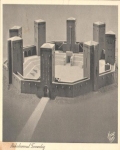Tannenberg Memorial
Archaeology »
Archaeological Monuments » Tannenberg Memorial
Tannenberg Memorial - Germany
Tannenberg Memorial is located in Tannenberg.
Tannenberg Memorial monument was established on 1927.
Primary threats to Tannenberg Memorial :
The architects of the memorial were the brothers Johannes and Walter Krüger, from Berlin. The memorial was built in 1927 by the Weimar Republic near Hohenstein (Ostpreuben) (now Olsztynek, Poland).
Historical facts of Tannenberg Memorial :
- Introduction :
The Tannenberg Memorial, established in 1927, stands as a poignant tribute to the fallen soldiers of the Battle of Tannenberg, one of the most significant clashes during World War I. Located near Olsztynek, Poland, the monument commemorates the bravery and sacrifice of German soldiers who fought valiantly in the battle. With its historical significance and solemnity, the Tannenberg Memorial serves as a place of remembrance and reflection on the profound impact of war.
- Historical Background :
The Battle of Tannenberg took place between August 26 and August 30, 1914, during the early stages of World War I. It was a major engagement between the German Empire and the Russian Empire in the region of East Prussia (now part of Poland). The battle was named after the nearby village of Tannenberg (now St?bark) and nearby bodies of water, rather than the historical Battle of Tannenberg that occurred in 1410.
- The German Eighth Army, led by Field Marshal Paul von Hindenburg and General Erich Ludendorff, faced the Russian Second Army, commanded by General Alexander Samsonov. Despite being outnumbered, the German forces utilized their strategic advantage and inflicted a crushing defeat on the Russians. The battle was a significant victory for Germany and bolstered their morale during the early stages of the war.
- Establishment of the Memorial :
In the aftermath of the Battle of Tannenberg, plans were set in motion to establish a memorial to honor the soldiers who fought and died in the conflict. The German government commissioned the renowned architect Walter Gropius, founder of the Bauhaus School, to design the monument. Gropius collaborated with the sculptor Ludwig Mies van der Rohe to create a powerful and emotive tribute.
- Design and Construction :
The Tannenberg Memorial was designed in the modernist style, which was pioneering at the time. The monument is characterized by its stark simplicity and geometric shapes, representing a departure from the more ornate and traditional memorials of the past. The centerpiece of the monument is a massive concrete obelisk, rising 34 meters high, symbolizing strength and resilience.
- On the obelisk's surface, an iron cross is carved, commemorating the German soldiers who fought for their country. Surrounding the obelisk is a circular stone platform that features bronze reliefs depicting scenes from the battle and the soldiers' experiences. These reliefs, sculpted by August Gaul, add depth and narrative to the monument, further humanizing the sacrifice made by those who fought.
- Inauguration and Significance :
The Tannenberg Memorial was inaugurated on September 3, 1927, on the 13th anniversary of the Battle of Tannenberg. The ceremony was attended by war veterans, military officials, and dignitaries, who came together to pay their respects to the fallen soldiers.
- The monument not only commemorates the Battle of Tannenberg but also serves as a symbol of national identity and pride for the German people. It represents a period of German history when the nation faced immense challenges and showcased the bravery and determination of its soldiers.
- Controversy and Shifting Perspectives :
Throughout its history, the Tannenberg Memorial has been a subject of controversy due to its association with the German military and the imperialist ambitions that led to World War I. Following World War II, the region surrounding the monument became part of Poland, adding another layer of complexity to its significance and interpretation.
- In the post-war era, the monument has been viewed differently by different groups. Some consider it a solemn remembrance of the sacrifice of soldiers, while others see it as a symbol of Germany's militaristic past. Despite these divergent viewpoints, the Tannenberg Memorial continues to be a site of historical importance and attracts visitors interested in both its architectural design and its historical context.
- Conclusion :
The Tannenberg Memorial stands as a powerful testament to the sacrifices made by soldiers during the Battle of Tannenberg in World War I. Its modernist design and symbolic representation of the German military's courage make it a unique and significant monument in the region. As a site of historical remembrance and contemplation, the Tannenberg Memorial invites visitors to reflect on the human cost of war and the enduring impact it leaves on nations and societies.

